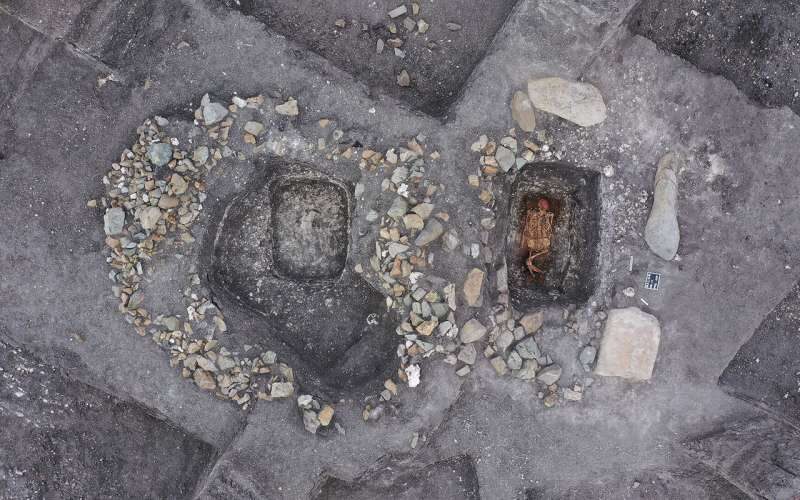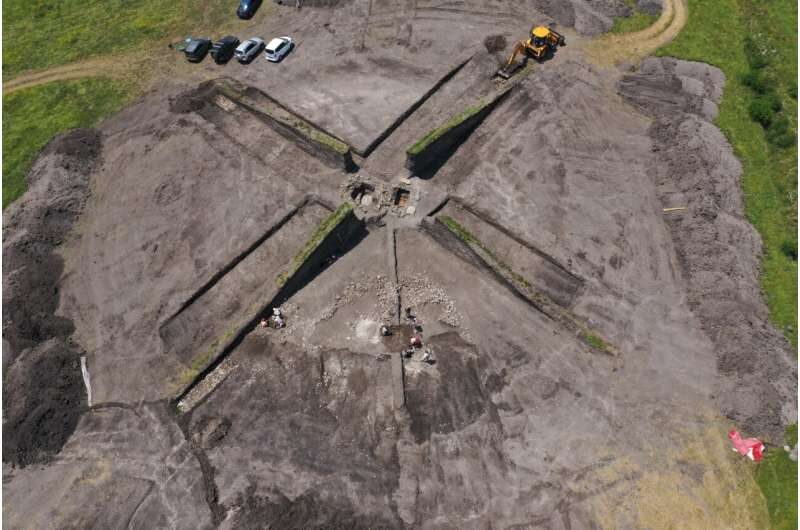Yamnayans were mobile cattle and sheep herders, now believed to be on horseback.
"Horseback-riding seems to have evolved not long after the presumed domestication of horses in the western Eurasian steppes during the fourth millennium BCE. It was already rather common in members of the Yamnaya culture between 3000 and 2500 BCE," says Volker Heyd, Professor of Archaeology at the University of Helsinki and a member of the international team that made the discovery.

Sites with individuals with skeletal markers for horsemanship are marked (black circles, Yamnaya; yellow circles, graves dated to other periods)
With the advent of ancient DNA research, the differences between these migrants from the east and members of local societies became even more pronounced.
"Our research is now beginning to provide a more nuanced picture of their interactions. For example, findings of physical violence as were expected are practically non-existent in the skeletal record so far. We also start understanding the complex exchange processes in material culture and burial customs between newcomers and locals in the 200 years after their first contact," explains Bianca Preda-Bălănică, another team member from the University of Helsinki.
Horse riding is a pivotal moment in human history
The use of animals for transport, in particular the horse, marked a turning point in human history. The considerable gain in mobility and distance had profound effects on land use, trade, and warfare. Current research has mostly focused on the horses themselves.
However, horse-riding is an interaction of two components — the mount and its rider — and human remains are available in larger numbers and more complete condition than early horse remains. Since horseback riding is possible without specialized equipment, the absence of archaeological finds with regard to earliest horsemanship does not come unexpected.
Traces of horsemanship can be found in the skeletons
"We studied over 217 skeletons from 39 sites of which about 150 found in the burial mounds belong to the Yamnayans. Diagnosing activity patterns in human skeletons is not unambiguously. There are no singular traits that indicate a certain occupation or behavior. Only in their combination, as a syndrome, symptoms provide reliable insights to understand habitual activities of the past," explains Martin Trautmann, Bioanthropologist in Helsinki and the lead author of the study published in Science Advances.

(A and B) The thickened and sclerotic frontal margin of two vertebrae and the concave deformation of the end plates. (C) The misaligned processus spinosus of the first sacral vertebra (photo credit: M. Trautmann, University of Helsinki). (D) A CT image of the same feature (lateral view), displaying the replacement of spongious tissue by compact bone
- Muscle attachment sites on pelvis and thigh bone (femur);
- Changes in the normally round shape of the hip sockets;
- Imprint marks caused by pressure of the acetabular rim on the neck of the femur;
- The diameter and form of the femur shaft;
- Vertebral degeneration caused by repeated vertical impact;
- Traumata that typically can be caused by falls, kicks or bites from horses.
If the primary use of horseback riding was as a convenience in a mobile pastoral lifestyle, in allowing a more effective herding of cattle, as means of swift and far-ranging raids or just as symbol of status needs further research.
Could it all have happened even earlier?
"We have one intriguing burial in the series," remarks David Anthony, emeritus Professor of Hartwick College U.S. and also senior co-author in the study.
"A grave dated about 4300 BCE at Csongrad-Kettöshalomin Hungary, long suspected from its pose and artifacts to have been an immigrant from the steppes, surprisingly showed four of the six riding pathologies, possibly indicating riding a millennium earlier than Yamnaya. An isolated case cannot support a firm conclusion, but in Neolithic cemeteries of this era in the steppes, horse remains were occasionally placed in human graves with those of cattle and sheep, and stone maces were carved into the shape of horse heads. Clearly, we need to apply this method to even older collections."
Who were the Yamnayans?
The Yamnayans were a population and culture that evolved in the Pontic-Caspian steppes at the end of the fourth millennium BCE.
By adopting the key innovation wheel and wagon, they were able to greatly enhance their mobility and exploit a huge energy resource otherwise out of reach, the sea of steppe grass away from the rivers, enabling them to keep large herds of cattle and sheep.
Thus committing to a new way-of-life, these pastoralists if not first true nomads in the world expanded dramatically within the next two centuries to cover more than 5,000 kilometers between Hungary in west and, in form of the so-called Afanasievo culture, Mongolia and western China in the east. Having buried their dead in grave pits under big mounds, called kurgans, the Yamnayans are said to be the first having spread proto-Indo-European languages.
More information: Martin Trautmann et al, First Bio-Anthropological Evidence for Yamnaya Horsemanship, Science Advances (2023). DOI: 10.1126/sciadv.ade2451. www.science.org/doi/10.1126/sciadv.ade2451
The Yamnaya Impact on Prehistoric Europe: www.helsinki.fi/en/researchgro ... n-prehistoric-europe
Journal information: Science Advances





Picture of the excavation site looks like an “X” remarkably. Lol